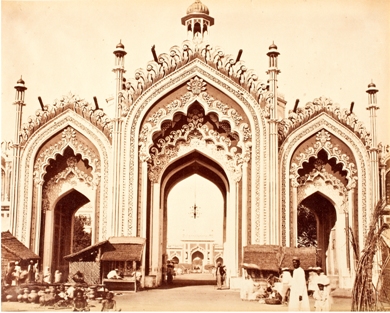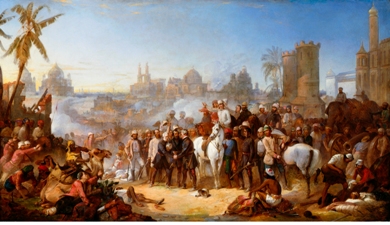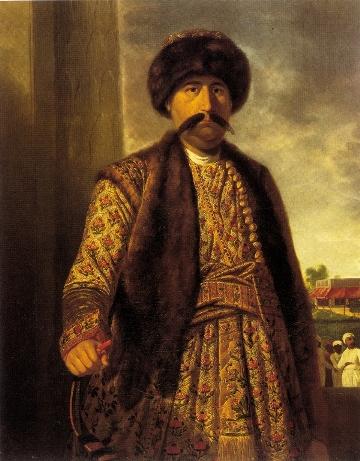If ever a story should start with “Once upon time,” India’s Fabled City is surely the one. It is hard to imagine a more perfect setting than Lucknow, this northern city nestled on the banks of the river Gomti where East met West which glowed for a moment with a luxurious promise of a shared, hybrid beauty. Here the culture of Awabh, a province of the great Sunni Muslim Mughal Empire, previously forbidden to Europeans, would ironically blossom with their presence. Lucknow, with a wealth of artistic forms of cultural history and expression would also be blessed with the leadership of Persian Shia religious thinking most dedicated to its enrichment and “fostering a sophisticated aesthetic vision,” as curator Stephen Markel so elegantly wrote in his essay in the accompanying book. As a result this beautiful city became a magnet for creative energy, attracting painters, musicians, poets, and entertainers who in turn brought the Britons (arrogant, disdainful) and the Europeans and all manner of fortune seekers of every nationality, dazzled by the courtly sumptuousness and sheer dynamic cross-cultural interplay of arts.
The nawabs, the ruling Shia elite in glorious regalia and extraordinary wealth with a complex history of shifting power between the Sunni and Hindu, were the relatively closed and richly endowed Persian Shia culture whose desire was to create a dynastic center. They were intensely immured by their own theatrical solipsistic obsessions, ancestral religious and ritualistic quest, and a labor of devotion. And yet they found themselves drawn to everything European—portrait painters, astronomers, coach makers, gunsmiths, cobblers, English tutors, and all manner of craftspeople. This attraction worked both ways. Formidable and ancient, the Indian culture was a mystery to the incoming foreigners. The array of jewel-like colors, and intimately choreographed dances had to be captivating to alien eyes. It was a world of intrigue, the perfume of an exotic culture, offering mysteriousness and an adventurer’s delight.

Tilly Kettle, "Shuja al-Daula, Nawab of Awadh, holding a bow," 1772, Yale Center for British Art, Paul Mellon Collection, photo © Yale Center for British Art, USA
The first of the portrait painters was Tilly Kettle, who went to Faizabad, the other city in Awabh, to paint the Shuja al-Daula and his sons. The large-scale portrait, new to Indian painting, suggested the nawabh’s power and majestic presence, complimenting their grandiose self-image. Kettle’s success was the impetus for others to follow, such as Jonann Zoffany. There were realistic images of the exquisite world of Lucknow and the mythology that resulted in its fall. The photography of John Edward Saché, Samuel Bourne and Felice Beato and the earliest of them, Baron Alexis de la Grange, would reveal a city of immense diversity and sweep, allowing us a sense of the real Lucknow. But its delicate and romantic vistas are captured in the Renaissance Dutch-like drawings in pencil by Captain Robert Smith, while William Carpenter’s renderings in sensitive watercolor and pencil give our Western eyes some verisimilitude of an understanding.

John Edward Saché, "Husainabad Bazaar Gateway," c. 1867, Catherine Benkaim and Barbara Timmer Collection
The Indian’s dynamic, evocative, and gloriously vibrant paintings and portraits by Muhammad Azam and Mihr Chand, and many others, record life in such radiance that even hunting scenes and military encampments take on the aura of a celebration. Wandering through the exhibition, these glorious moments of commingled art reveal themselves—a union of worlds apparently balancing between pomp and desire, power and heritage. A world is revealed through the imposing architecture, the elaborate dress, and the decorative metalware in rich detail and the sensual tenet and complexity of their social graces.

Base for a Water Pipe (huqqa), c. 1700-1750, India, Uttar Pradesh, Lucknow, LACMA, from the Nasli and Alice Heeramaneck Collection, photo © 2011 Museum Associates/LACMA
I worry about the nightingales
Now that spring has come:
The hunter pitches his camp
Right outside the garden.
—A line from Urdu poetry
In this feast of art, money, goods, and services, the dark shadow of the English East India Company, a predatory trading enterprise, had insinuated itself as a political power into Lucknow’s ruling agenda (redolent of the British colonial, expansionistic aims and their Imperial hubris in the Awadh’s territory). In what can only be described as Machiavellian design, the company took control of Nawadh rulers through a series of forced concessions and downright economical chicanery, resulting in total control. Awadh was annexed by the English East India Company in 1856. There would follow the Great Uprising in 1857. There would be blood. A siege. A slaughter. And heroic tales told by the victor, in paint: Thomas Jones Barker’s The Relief of Lucknow or Frederick Goodall’s Jessie’s Dream (The Relief of Lucknow).

Thomas Jones Barker, "The Relief of Lucknow," 1857-59, National Portrait Gallery, London, 5851, photo © National Portrait Gallery, London
Lucknow became the source of great wealth for many. And yet this glittering moment would glow, fablelike, through history and time in spite of the darkness that fell upon it and the blood that was spilled.
Hylan Booker



